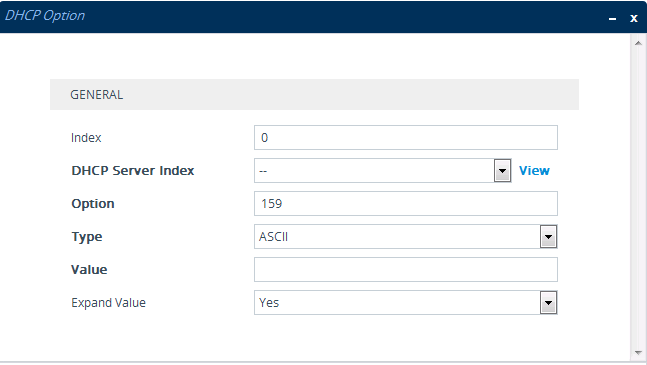Configuring Additional DHCP Options
The DHCP Option table lets you configure up to 10 additional DHCP Options that the DHCP server can use to service the DHCP client. These DHCP Options are included in the DHCPOffer response sent by the DHCP server.
The following procedure describes how to configure DHCP Options through the Web interface. You can also configure it through ini file [DhcpOption] or CLI (configure network > dhcp-server option).
The additional DHCP Options configured in the DHCP Option table override the default ones, which are configured in the DHCP Servers table. In other words, if you configure Option 67 in the DHCP Option table, the device uses the value configured in the DHCP Option table instead of the value configured in the DHCP Servers table.
| ➢ | To configure DHCP Options: |
| 1. | Open the DHCP Servers table (see Configuring the DHCP Server). |
| 2. | Select the row of the desired DHCP server for which you want to configure additional DHCP Options, and then click the DHCP Option link located below the table; the DHCP Option table opens. |
| 3. | Click New; the following dialog box appears: |

| 4. | Configure additional DHCP Options for the DHCP server according to the parameters described in the table below. |
| 5. | Click Apply. |
DHCP Option Table Parameter Descriptions
|
Parameter |
Description |
|||||||||
|---|---|---|---|---|---|---|---|---|---|---|
|
'Index' dhcp option [Index] |
Defines an index number for the new table row. Note: Each row must be configured with a unique index. |
|||||||||
|
'DHCP Server Index' dhcp-server-number [DhcpServerIndex] |
Associates the DHCP Option table entry with a DHCP server that you configured in Configuring the DHCP Server. Note: Currently, only one DHCP server (Index 0) can be configured and therefore, the parameter is always set at 0. |
|||||||||
|
'Option' option [Option] |
Defines the code of the DHCP Option. The valid value is 1 to 254. The default is 159. For example, for DHCP Option 150 (Cisco proprietary for defining multiple TFTP server IP addresses), enter the value 150. |
|||||||||
|
'Type' type [Type] |
Defines the format (type) of the DHCP Option value that is configured in the 'Value' parameter (see below).
For example, if you configure the 'Value' parameter to "company.com" (without quotation marks), you need to configure the 'Type' parameter to ASCII. |
|||||||||
|
'Value' value [Value] |
Defines the value of the DHCP Option. For example, if you are using Option 66, the parameter is used for specifying the TFTP provisioning server (e.g., http://192.168.3.155:5000/provisioning/). The valid value is a string of up to 256 characters. By default, no value is defined. For IP addresses, the value can be one or more IPv4 addresses, each separated by a comma (e.g., 192.168.10.5,192.168.10.20). For hexadecimal values, the value is a hexadecimal string (e.g., c0a80a05). You can also configure the parameter with case-sensitive placeholder strings that are replaced with actual values if the 'Expand Value' parameter (see below) is set to Yes:
|
|||||||||
|
'Expand Value' expand-value [ExpandValue] |
Enables the use of the special placeholder strings, "<MAC>" and "<IP>" for configuring the 'Value' parameter (see above).
Note: The parameter is applicable only to values of type ASCII (see the 'Type' parameter, above). |